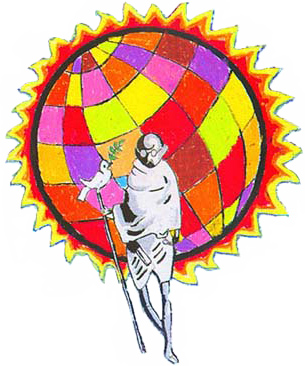
“The Path shown by Bapu is the solution to the present problems”. Mary I. Vanvahati/ GandhiServe, 7th class, S.N. Kansagara School, Rajkot, India. Prize winner in the running inter-school drawing competition “GANDHI AS I SEE HIM”, Rajkot, India, 1991, organized by Gandhi Information Center, Germany
 n the conventional narrative, Indian history begins with the birth of the Indus Valley Civilization in such sites as Mohenjo-Daro, Harappa, and Lothal, followed by the coming of the Aryans. These two phases are usually described as the pre-Vedic and Vedic periods. It is in the Vedic period that Hinduism first arose, though some elements of Hinduism are clearly drawn from the Indus Valley civilization. In the fourth century BCE, large parts of India were united under the emperor Ashoka; he also converted to Buddhism, and it is in his reign that Buddhism first spread to other parts of Asia. It is during the time of the Mauryas that Hinduism first began to take the shape that fundamentally informs the religion down to the present day, though popular or Puranic Hindism is generally dated to around the beginning of the Christian Era. Successor states were more fragmented. Islam first came to India in the eighth century, and by the eleventh century had firmly established itself in India as a political force; the North Indian dynasties of the Lodhis, Tughlaqs, and numerous others, whose remains are visible in Delhi and scattered elsewhere around North India, were finally succeeded by the Mughal empire, under which India once again achieved a large measure of political unity. These are certainly the generally accepted contours of Indian history before the advent of colonialism, though specialists are all inclined to write this history with particular emphases and accents.
n the conventional narrative, Indian history begins with the birth of the Indus Valley Civilization in such sites as Mohenjo-Daro, Harappa, and Lothal, followed by the coming of the Aryans. These two phases are usually described as the pre-Vedic and Vedic periods. It is in the Vedic period that Hinduism first arose, though some elements of Hinduism are clearly drawn from the Indus Valley civilization. In the fourth century BCE, large parts of India were united under the emperor Ashoka; he also converted to Buddhism, and it is in his reign that Buddhism first spread to other parts of Asia. It is during the time of the Mauryas that Hinduism first began to take the shape that fundamentally informs the religion down to the present day, though popular or Puranic Hindism is generally dated to around the beginning of the Christian Era. Successor states were more fragmented. Islam first came to India in the eighth century, and by the eleventh century had firmly established itself in India as a political force; the North Indian dynasties of the Lodhis, Tughlaqs, and numerous others, whose remains are visible in Delhi and scattered elsewhere around North India, were finally succeeded by the Mughal empire, under which India once again achieved a large measure of political unity. These are certainly the generally accepted contours of Indian history before the advent of colonialism, though specialists are all inclined to write this history with particular emphases and accents.
The European presence in India dates to the sixteenth century, and it is in the very early part of the eighteenth century that the Mughal empire began to disintegrate, paving the way for regional states. In the contest for supremacy, the English emerged victors, their rule marked by the conquests at the battlefields of Plassey and Buxar. The Rebellion of 1857-58, which sought to restore Indian supremacy, was crushed; and with the subsequent crowning of Victoria as Empress of India, the incorporation of India into the empire was complete. By the early part of the twentieth century, a nationalist movement had emerged; and by 1919-20, Mohandas Karamchand (‘Mahatma’) Gandhi had emerged as, if not the virtually undisputed leader of this movement, certainly its most well-known and formidable architect. Successive campaigns had the effect of driving the British out of India in 1947, but not before they had partitioned it, and carved out the Muslim-majority state of Pakistan — later itself dismembered into Pakistan and Bangladesh..
The first prime minister of independent India was Jawaharlal Nehru, who held office from 1947 until his death in 1964. Apart from a short period of two years from 1975-77, when an internal emergency was imposed by then-Prime Minister Indira Gandhi and constitutional liberties were suspended, India has been a thriving parliamentary democracy. For a capsule political history of India in the post-1947 period, readers are invited to turn to the “Independent India” section of this site, where they will also find other specialized articles, as well as the “Current Affairs” section of MANAS, where readers will be able to find articles on selected political and social phenomena of recent years.
For a translation into Kazakh by Alana Kerimova of this page, go to: http://theworkscited.com/history-and-politics/
For a translation into Swedish by Daniela Milton of this page, go to:
http://www.autoteilexxl.de/edu/?p=2750
For a translation into Bosnian by Petra Vlasic of this page, go to:
http://petravlasic.net/mainhist/
Copyright: Vinay Lal, 1998 & 2007


